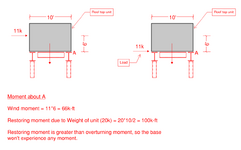Samwise Gamgee
Structural
- Oct 7, 2021
- 115
I have a heavy roof top unit which is supported on a steel frame which sits on HSS posts. The base connections of RTU to the steel frame can only transfer shear. As the unit is heavy and the resisting moment is greater than the overturning moment , can we idealize this as a rigid body and design the frame only for shear at the bottom of the unit as shown in the second image ?


